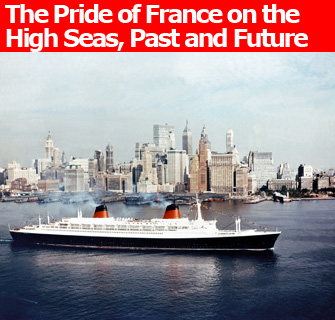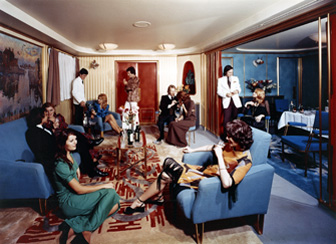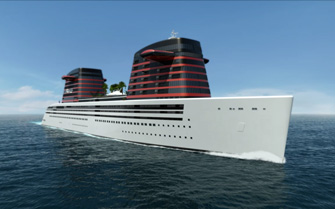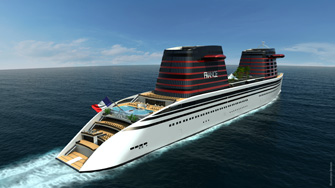 |
|
The original France in front of the New York skyline. Coll. French Lines © French Lines |
Does anything sound more appealing in the age of agonizing low-cost flights and cramped plane seating than a long, slow ocean crossing in a luxury …
 |
|
The original France in front of the New York skyline. Coll. French Lines © French Lines |
Does anything sound more appealing in the age of agonizing low-cost flights and cramped plane seating than a long, slow ocean crossing in a luxury liner? Aah, the enforced idleness, that feeling of being nowhere in particular, in between two places, with no special obligations. Bliss. And then there is the appealingly romantic image of transatlantic travel as seen in films from the 1930s, in which passengers dressed for dinner, gambled and gamboled and danced and fell in love and got mixed up in all kinds of shenanigans. For Marx Brothers fans, of course, the famous stateroom scene from A Night at the Opera leaps to mind.
For the French, the ultimate ocean liner, the one that holds a special place in their hearts, is the France. After the humiliating years of World War II, the country prospered during Les Trente Glorieuses, three decades of postwar growth, and the France is one of the symbols of that happy period. People here remember the ship, made entirely with French parts to show off the country’s technological prowess, with a special fondness and mourn its sad end. Designer Philippe Starck notes that it was responsible for one of the “few important moments when France was really proud of itself.” Luckily, a new France will soon take to the sea to replace it, but more on that later.
On the 50th anniversary of the birth of the original, the Musée de la Marine’s exhaustive exhibition, “Paquebot France,” covers everything you could possibly want to know about it, offering a nostalgic voyage into the past for French visitors.
After a short exposition of the history of ocean liners, the exhibition delves into the technical details that went into the construction of the fabled France. The technologically minded will linger here, while the rest of us move quickly on to images of the launch by its “godmother,” Yvonne de Gaulle, wife of the president, on May 11, 1960, an event that attracted 100,000 people. To give you an idea of how eagerly anticipated the France was, some people booked as early as 1956 for its maiden transatlantic voyage, which took place in February 1962.
The exhibition then turns to what for me are the most interesting topics: the interior decoration and images of life on board. The France’s decor was 1950s modern, but did not start any
 |
|
Socializing in the France’s “Normandie” apartment. Coll. French Lines © Chevojon |
revolutions in design – a number of designers contributed, and their work had to be approved by a committee. The innovations lay in the use of materials like aluminum, vinyl, lacquered metal and Formica, and the lavish use of bright colors like absinthe, mustard, turquoise and tobacco. Many artworks, including murals, tapestries, paintings and sculptures, were commissioned for it. The boat had its own hospital, operating room, swimming pools, cinema and theater, and even a TV studio to produce news broadcasts for passengers.
The bric-a-brac of onboard life on show includes tableware, menus, free mini-packs of Gitanes cigarettes, matchbooks, staff uniforms and so on. Photos, ad campaigns, posters and films give an impression of onboard fun, with dress balls, bar scenes, passengers lounging on the deck (hot bouillon was served to chilled deck-chair occupants at 11am), shuffleboard games and so on. The show ends with a large collection of kitschy memorabilia associated with the ship: ashtrays, key chains, jigsaw puzzles, etc.
A victim of competition from the airlines (to which a room in the show is devoted), the France died a slow death. Running at a loss, it was set to be decommissioned in 1974, and even though – in good French fashion – its crew went on strike in protest, the inevitable was only slightly delayed. After several years in the “Quai de l’Oubli,” it was sold and in 1980 became the Norway, a Caribbean cruiser. An explosion in 2003 that killed eight crew members sounded the ship’s death knell. This symbol of France’s postwar glory years took its last trip in 2007, to be broken up for scrap in India.
It did not completely disappear, however. In 2009, the contents of the France were auctioned off at Artcurial in Paris. The ship’s nose, estimated at €80,000-€100,000, set off a bidding war between two men. One of them, a boat-loving businessman named Didier Spade, had set himself a bidding limit, but in the heat of the moment went far beyond it. He finally gave up, however, and the nose was knocked down to his competitor for €273,162.
The two men got talking afterward, and once the winner had used the nose for a promotional event, he no longer needed it and lent it to Spade, who put it on display at his yacht marina on the Seine. Inspired, Spade, the grandson of one of the decorators of the original France, decided he would design and build a new France.
The design he has come up with is sleek, high-tech and thoroughly modern while subtly
  |
|
Computer simulations of the new Paquebot France, which will make its maiden cruise in 2015. |
echoing certain features of the original France. The distinctive chimneys of the original, for example, were designed that way for aerodynamic reasons, but technological developments have now rendered them obsolete. They have been reborn as chimney-shaped towers on the new Paquebot France (the name has been officially attributed to Spade’s project) and will contain living quarters, restaurants and lounges. At the bow end, the ship’s decks step down toward the sea.
Like its predecessor, the new France will be built in Saint Nazaire, France, using French workmanship and parts. Anyone can invest, even small amounts, in the project. The 260-meter-long new luxury liner, estimated to cost €300,000, will have seven restaurants, a wine bar, five bars, a palm grove and two swimming pools. Each stateroom, with a minimum area of 30 square meters, looks out to sea, and most have balconies. The ship will carry 700 passengers and a crew of 370, and will take to the sea in 2015. Better book now for the maiden voyage.
In the meantime, the nose of the original France and an exhibition on the new France can be seen at the Atelier de France, a wine bar Spade has opened at his yacht marina on the Seine. A display in the Musée de la Marine and a Web site also explain the project.
Musée National de la Marine: Palais de Chaillot, 17, place du Trocadéro, 75116 Paris. Métro : Trocadéro. Tel.: 01 53 65 69 69. Open Monday, Wednesday, Thursday, 11 a.m.-6 p.m.; Friday, 11am-9:30pm; Saturday-Sunday, 11am-7pm. Admission: €9. Through October 23. www.musee-marine.fr Click here for exhibition site.
Reader Michael Harrington writes: “Many and sincere thanks for your article about the France. I had the unforgettable pleasure of sailing on the final voyage. I was heading to the Sorbonne for my junior year abroad with about 35 other American students, several of whom became lifelong friends (and one of whom is arriving in Paris this Friday with plans to visit the exposition – and perhaps even see some familiar photos from the disembarkment). I still have the Time magazine article about the landing. Many of the students in our program had trunks of clothing which, for reasons having to do with the strike, didn’t arrive in Paris for several months after we landed, but that didn’t dampen our spirits or spoil our memories: we just swapped sweaters and shared stories of which crew members we’d made out with after hours! What can I say? We were nineteen years old and eager to embrace all things French!
“It was an altogether grand and glorious experience which we’ve reminisced about for decades (although watching the extraordinary storm-at-sea sequence from David Lean’s film Ryan’s Daughter in one of the boat’s cinemas was quite surreal, to say the least). The service and amenities were especially marvelous throughout the voyage, and the crew even issued lovely printed apologies for the inconvenience of having to be unloaded onto Norwegian fishing vessels upon arrival at Le Havre. We were very much in agreement with their disapproval of what was happening to the ship, and their gentle but firm politesse regarding that unfortunate fate touched us all. In a spirit of solidarity, “vive la France!” became “vive Le France!” and it’s gratifying to know that an exhibit dedicated to it will now attract visitors and offer them a glimpse into what it was like to be a passenger on a transatlantic luxury liner. It was a world of its own.”
Please support Paris Update by ordering books from Paris Update’s Amazon store at no extra cost. Click on your preferred Amazon location: U.K., France, U.S.
Reader Reaction: Click here to respond to this article (your response may be published on this page and is subject to editing).
© 2010 Paris Update
Favorite